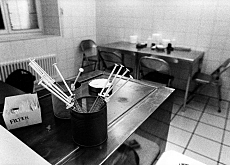Retirement homes planned for junkies

Junkies are living longer in Switzerland thanks to the government's drugs policy, leading to a demand for residential care for elderly drug users.
Emergency shelters have identified a need for such long-term accommodation and the Obdach shelter in Lucerne has taken on the task of providing a new home for drug-dependent clients. Similar projects already exist in Zurich and Basel.
Rooms in the Lucerne night shelter are functional and sparsely furnished, intended for people in need who are just passing through.
However, the average stay per person has increased sharply, from 10 nights on average in 2004 to 15.5 nights on average last year.
Ageing addicts
One significant change in the profile of clients in recent years is an increase in older drug addicts in need of care, Urs Schwab, head of Obdach told swissinfo.ch.
“Thanks to the state’s four-pillar drugs policy [state-sanctioned distribution of heroin or substitute drugs on prescription since 1994, among other measures], drug addicts are living longer,” he explained.
But the years weigh more heavily on drug addicts. The physical and mental condition of a 50-year-old drugs consumer is comparable to a 70 year old in the general population.
“These people are absolutely not in the right place; we have neither the infrastructure nor the training to care for them adequately,” Schwab said.
“It is not humane that people in need of care have to stay in an emergency shelter,” he added.
Taking action
However, housing long-term drug addicts in regular retirement homes has led to massive problems, in particular in preventing the residents from having unauthorised access to medication.
These problems led the association that runs Obdach to take action. The Jobdach Association is currently drawing up a living concept for drug, alcohol and medication dependent individuals.
Social services in Lucerne estimate there are 80 affected people living locally.
Zurich has had a residence, with in-house doctor, catering for long-term drug users since 2007. Many of the residents were previously homeless and most are being treated with methadone or similar heroin substitute.
This is no ordinary home – the consumption of illegal drugs is allowed on the premises.
“The concept has proved worthwhile,” Marianne Spieler, head of the Zurich home BeWo City said. “The demand is high, more facilities like this are needed,” she added.
A similar residential pilot project for elderly addicts began in Basel earlier this month, an initiative of Sternenhof, an association that provides sheltered housing for the elderly.
Contradiction
Establishing old folks homes for drug addicts which perpetuate their addiction could seem at odds with the stated goal of the national drugs policy, which is abstinence.
But Mona Neidhart of the Federal Health office doesn’t see a conflict.
“Drug addiction is, according to the most recent brain research, a chronic illness,” she told swissinfo.ch.”It cannot be expected of every addicted person to become clean.”
Substitution programmes may therefore carry on into advanced age and even until death.
“It is often a case of palliative medical treatment,” Neidhart said.
Corinne Buchser in Lucerne, swissinfo.ch (adapted from German by Clare O’Dea)
The open drug scene in Zurich’s Platzspitz became infamous at the end of the 1980s because of the public display of drug taking and regular overdoses. The park was cleared in 1991.
In 1986 the first drop-in centre for drug addicts opens where they are allowed to shoot-up. Clean needles and advice are provided. The question of whether the state should tolerate drug consumption in publicly-run facilities splits public opinion.
1994 sees the introduction of the first state programme of methadone dispensing under medical supervision.
In November 2008, Swiss voters approved the revised drugs law. The vote enshrined in law the four-pillar approach to drugs – based on prevention, therapy, damage limitation and repression – which was developed in 1992.
The new law also provided a legal basis to the controlled dispensing of heroin which had been taking place on a trial basis up to that point.
At the end of July 2008 there were 1,300 heroin patients attending 21 walk-in and 2 prison centres. Some 16,000 people were receiving prescribed methadone.

In compliance with the JTI standards
More: SWI swissinfo.ch certified by the Journalism Trust Initiative












You can find an overview of ongoing debates with our journalists here . Please join us!
If you want to start a conversation about a topic raised in this article or want to report factual errors, email us at english@swissinfo.ch.